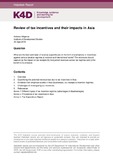| dc.contributor.author | Megersa, Kelbesa | |
| dc.coverage.spatial | Asia | en |
| dc.date.accessioned | 2019-10-24T10:36:10Z | |
| dc.date.available | 2019-10-24T10:36:10Z | |
| dc.date.issued | 2019-09-30 | |
| dc.identifier.citation | Megersa, K. (2019). Review of tax incentives and their impacts in Asia. K4D Helpdesk Report. Brighton, UK: Institute of Development Studies. | en |
| dc.identifier.uri | http://opendocs.ids.ac.uk/opendocs/handle/20.500.12413/14753 | |
| dc.description.abstract | This rapid literature review summarises the existing evidence on tax incentives and their consequences (i.e. benefits and costs) in Asia. This report provides a review of academic papers, policy briefs, and other reports on the topic. As a means of promoting investment in Asian countries, tax incentives have been widely used. However, there are conflicting arguments about the effectiveness of using tax incentives to promote investment. In some circumstances, tax incentives may be effective, but they also pose several challenges, including tax revenue losses, distortion of resource allocation in the economy, and additional complexity in the tax system. (Oxfam and UN, 2016; IMF et al., 2015; IFS, 2018). Even if there are some reports and studies that estimate the revenue costs of tax incentives, they are limited in scope and accuracy. Thus, it may be difficult to accurately measure the overall effect of tax incentives - since the negative effects may be offset by positive effects to varying degrees (often based on local institutions and international factors). Fourth, since studies on the topic are forced to focus on a specific type of incentive (i.e. for simplicity and precision), it is daunting to arrive on a specific country-level estimate. Even more difficult (and less reliable) is the effort to evaluate multiple countries using comparable estimates (see Sections 2 and Annexes).
For these reasons, the literature (and this report/review) will be mainly specific to the scope of each study and respective country. Further, brief notes on the difficulties linked to research methodologies and political economy of developing countries (i.e. while estimating costs of tax incentives) are given in Section 4. This report also does not exhaustively cover the experiences of all Asian (South and East) countries. The list of countries covered is, rather, selective and dependent on the availability of suitable literature. | en |
| dc.language.iso | en | en |
| dc.publisher | IDS | en |
| dc.relation.ispartofseries | K4D Helpdesk Report;665 | |
| dc.rights.uri | https://www.nationalarchives.gov.uk/doc/open-government-licence/version/3/ | en |
| dc.subject | Economic Development | en |
| dc.subject | Finance | en |
| dc.subject | Governance | en |
| dc.title | Review of Tax Incentives and Their Impacts in Asia | en |
| dc.type | Helpdesk | en |
| dc.rights.holder | © DFID - Crown copyright 2019 | en |
| dcterms.dateAccepted | 2019-09-30 | |
| rioxxterms.funder | Department for International Development, UK Government | en |
| rioxxterms.identifier.project | K4D | en |
| rioxxterms.version | VoR | en |
| rioxxterms.funder.project | 238a9fa4-fe4a-4380-996b-995f33607ba0 | en |

